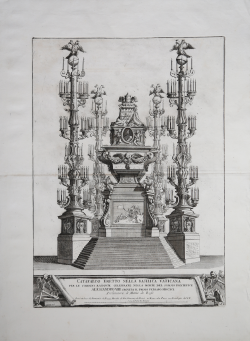- New




| Reference: | S52130 |
| Author | Alessandro SPECCHI |
| Year: | 1691 |
| Printed: | Rome |
| Measures: | 350 x 490 mm |



| Reference: | S52130 |
| Author | Alessandro SPECCHI |
| Year: | 1691 |
| Printed: | Rome |
| Measures: | 350 x 490 mm |
CATAFALCO ERETTO NELLA BASILICA VATICANA PER LE SOLENNI ESSEQUIE CELEBRATE NELLA MORTE DEL SOMMO PONTEFICE ALESSANDRO VIII, SEGUITA IL PRIMO FEBRARO MDCXCI. Architettura di Mattia De Rossi, dato in luce da Domenico De Rossi, herede di Gio. Giacomo de Rossi, in Roma alla Pace con privilegio del S.P.
Etching, 1691, signed on the plate lower left A. S. del. Scul.
The engraving depicts the catafalque erected in the Vatican for the funeral of Pope Alexander VIII, born Pietro Ottoboni (1610-1691), celebrated on February 1, 1691.
After the death of Alexander VIII, as was customary, the College of Cardinals commissioned a catafalque to be erected in St. Peter's Basilica; the architect was Mattia de Rossi.
In the 17th and 18th centuries, the catafalque-monument became established for the funerals of sovereigns and pontiffs, an elaboration of the funerary monuments in use in the 16th century. The papal catafalque model arose from a sort of fusion between the imperial pyramidal model and the circular "tholos" temple of Hellenistic origin, with a series of variations determined by the prevalence of one component over the other or by the addition of compositional and decorative elements.
As stated in the Funeral Report , the Esatta descrizione dell’Essequie fatte nella Basilica Vaticana alla Santità di N.S.PP. Alessandro VIII di felicissima memoria: “Era la mancina di forma quadrata, figurata in marmi di vari colori, e le quattro cantonate sovra le quali si posano le colonne della stessa pittura che aveano molti bracci in fuori, in cinque ordini, ov’erano grosse candele di cera bianca, e in cima il Mondo coll’Aquila. Nel mezzo da queste colonne sovr’un piano rilevato assai, a cui per quattro scalinate laterali si saliva, si alzava il sepolcro, a cui si passeggiava attorno; e sovra l’urna, alzata in forma piramidale cuoperta con una coltre di broccato d’oro…ilumi che adornavano tutta la Macchina erano disposti da alto a basso con ordine meraviglioso”.
A very good impression, printed on contemporary laid paper with margins, a small wormhole along the central fold, otherwise in excellent condition. Rare.
Bibliografia
Incisioni barocche di feste e avvenimenti, p. 127; L’Effimero Barocco, I p. 329.
Alessandro SPECCHI (Roma, 1668 - Roma, 1729)
|
Italian architect, urban planner and engraver. He studied architecture in the studio of Carlo Fontana and assisted in the construction of Fontana’s chapel of St Fabian (c. 1706) in S Sebastiano fuori le Mura in Rome. From at least 1684 he produced sets of architectural engravings. Many of these were published by Giovanni Giacomo de’ Rossi and his son Domenico de’ Rossi ( fl 1684–1721), including 52 engravings for Quarto libro del nuovo teatro di palazzi di Roma (Rome, 1699); some of the original plates are housed in the Calcografia Nazionale in Rome. Domenico de’ Rossi’s Studio d’architettura civile (1702–21) provides an architectural record of the city of Rome in 286 plates engraved by Specchi.
|
Alessandro SPECCHI (Roma, 1668 - Roma, 1729)
|
Italian architect, urban planner and engraver. He studied architecture in the studio of Carlo Fontana and assisted in the construction of Fontana’s chapel of St Fabian (c. 1706) in S Sebastiano fuori le Mura in Rome. From at least 1684 he produced sets of architectural engravings. Many of these were published by Giovanni Giacomo de’ Rossi and his son Domenico de’ Rossi ( fl 1684–1721), including 52 engravings for Quarto libro del nuovo teatro di palazzi di Roma (Rome, 1699); some of the original plates are housed in the Calcografia Nazionale in Rome. Domenico de’ Rossi’s Studio d’architettura civile (1702–21) provides an architectural record of the city of Rome in 286 plates engraved by Specchi.
|